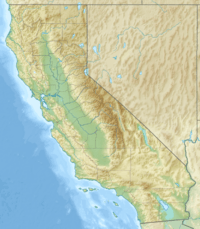Mount Agassiz (California) facts for kids
Quick facts for kids Mount Agassiz |
|
|---|---|

Mount Agassiz from Bishop Pass Trail.
|
|
| Highest point | |
| Elevation | 13,899 ft (4,236 m) NAVD 88 |
| Prominence | 893 ft (272 m) |
| Parent peak | North Palisade |
| Listing |
|
| Geography | |
| Location | Fresno and Inyo counties, California, U.S. |
| Parent range | Palisades, Sierra Nevada |
| Topo map | USGS North Palisade |
| Climbing | |
| First ascent | August 30, 1925 by Norman Clyde |
| Easiest route | West slope, scramble, (class 2) |
Mount Agassiz is a really tall mountain in California, standing at 13,899 feet (4,236 m) high! It's one of the 20 highest peaks in the whole state. This mountain is the most northern and easiest to climb among the big Palisades mountains. It's important not to mix it up with another mountain called Mount Agassiz in Desolation Wilderness. That one is 9,967-foot (3,038 m) tall and is also in the California Sierra Nevada mountains.
Contents
Where is Mount Agassiz?
Mount Agassiz is located at the northern end of the Palisades mountain range. This range is part of the eastern Sierra Nevada mountains. It's found close to Bishop Pass. The mountain sits right on the border between Kings Canyon National Park and Inyo National Forest. It also divides Fresno and Inyo counties.
The Story Behind the Name
In 1879, a person named Lilbourne Winchell gave the mountain its original name, Agassiz Needle. He named it after Louis Agassiz, a famous professor. Louis Agassiz taught about animals (zoology) and rocks (geology) at Harvard University. Later, the USGS officially recognized it by its current name, Mount Agassiz. The name Agassiz Needle was first used for a different nearby peak, probably Mount Winchell. But over time, the name moved to the mountain we now call Mount Agassiz.
Climbing Mount Agassiz
There are three main ways to reach the top of Mount Agassiz. The simplest way is by climbing the west slope. This path is not very technical and is close to the Bishop Pass Trail.
The Easiest Path
To start, you can take a trail from South Lake. This trail goes up gently to Bishop Pass. The path to the summit begins right there. If you try to go up from the west through a narrow channel, you might get off track. This could lead you to areas that need more advanced climbing skills and special gear.
Other Climbing Routes
Another way to climb, which involves some scrambling (climbing with hands and feet), is the southeast face. This route goes by way of the south ridge, starting from Agassiz Col. For climbers looking for a bigger challenge, there's the northeast face. This route is more technical and requires advanced climbing skills. Norman Clyde was the first to climb this route. He followed a canyon, a steep gully (couloir), and a sharp ridge (arête) from Fifth Lake.




